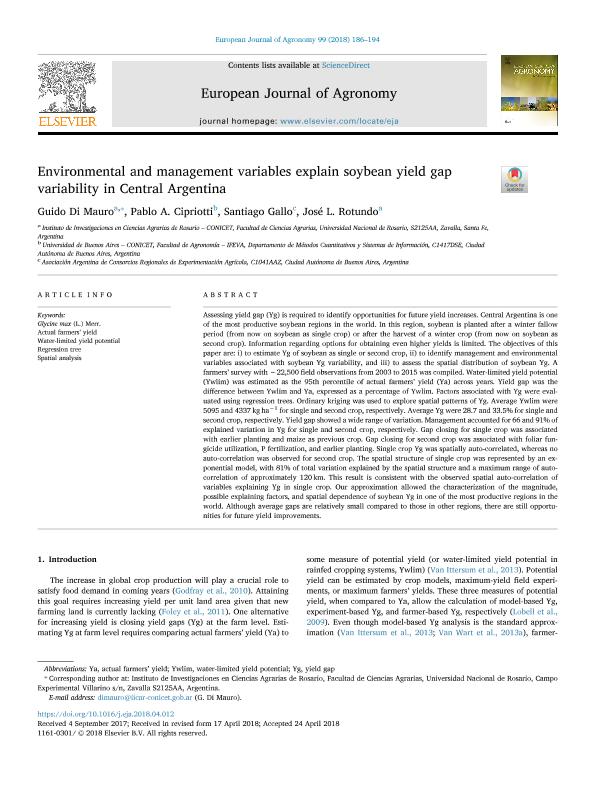Artículo
Environmental and management variables explain soybean yield gap variability in Central Argentina
Fecha de publicación:
09/2018
Editorial:
Elsevier Science
Revista:
European Journal of Agronomy
ISSN:
1161-0301
Idioma:
Inglés
Tipo de recurso:
Artículo publicado
Clasificación temática:
Resumen
Assessing yield gap (Yg) is required to identify opportunities for future yield increases. Central Argentina is one of the most productive soybean regions in the world. In this region, soybean is planted after a winter fallow period (from now on soybean as single crop) or after the harvest of a winter crop (from now on soybean as second crop). Information regarding options for obtaining even higher yields is limited. The objectives of this paper are: i) to estimate Yg of soybean as single or second crop, ii) to identify management and environmental variables associated with soybean Yg variability, and iii) to assess the spatial distribution of soybean Yg. A farmers’ survey with ∼22,500 field observations from 2003 to 2015 was compiled. Water-limited yield potential (Ywlim) was estimated as the 95th percentile of actual farmers’ yield (Ya) across years. Yield gap was the difference between Ywlim and Ya, expressed as a percentage of Ywlim. Factors associated with Yg were evaluated using regression trees. Ordinary kriging was used to explore spatial patterns of Yg. Average Ywlim were 5095 and 4337 kg ha−1 for single and second crop, respectively. Average Yg were 28.7 and 33.5% for single and second crop, respectively. Yield gap showed a wide range of variation. Management accounted for 66 and 91% of explained variation in Yg for single and second crop, respectively. Gap closing for single crop was associated with earlier planting and maize as previous crop. Gap closing for second crop was associated with foliar fungicide utilization, P fertilization, and earlier planting. Single crop Yg was spatially auto-correlated, whereas no auto-correlation was observed for second crop. The spatial structure of single crop was represented by an exponential model, with 81% of total variation explained by the spatial structure and a maximum range of auto-correlation of approximately 120 km. This result is consistent with the observed spatial auto-correlation of variables explaining Yg in single crop. Our approximation allowed the characterization of the magnitude, possible explaining factors, and spatial dependence of soybean Yg in one of the most productive regions in the world. Although average gaps are relatively small compared to those in other regions, there are still opportunities for future yield improvements.
Archivos asociados
Licencia
Identificadores
Colecciones
Articulos(IICAR)
Articulos de INST. DE INVESTIGACIONES EN CIENCIAS AGRARIAS DE ROSARIO
Articulos de INST. DE INVESTIGACIONES EN CIENCIAS AGRARIAS DE ROSARIO
Citación
Di Mauro, Guido; Cipriotti, Pablo Ariel; Gallo, Santiago; Rotundo, José Luis; Environmental and management variables explain soybean yield gap variability in Central Argentina; Elsevier Science; European Journal of Agronomy; 99; 9-2018; 186-194
Compartir
Altmétricas




